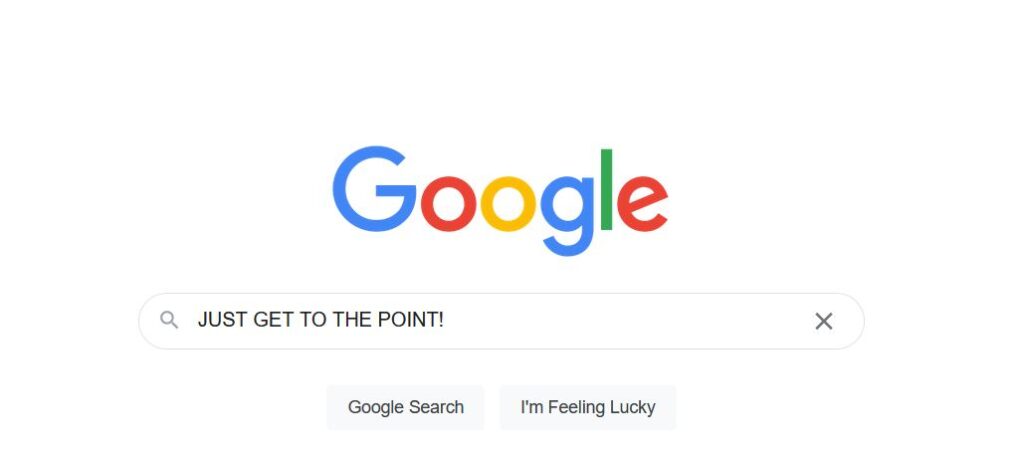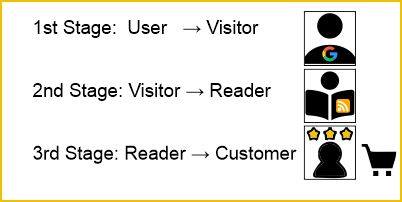Want to know the main secret of SEO copywriting success? Get straight to the point! It’s not just considered a best practice from a search engine perspective, it also makes for happy readers. In this article you will learn why this is the most important point when publishing online. You will also learn about search intent and how it helps to convert visitors to users and clicks into customers. Your first step to successful SEO copywriting starts here! So let’s…

Cut To The Chase
Think back to the last time you needed information in a hurry but didn’t find it. You read the first couple of lines then started skimming down the page and maybe scrolled for a bit before giving up and looking elsewhere. Remember how frustrating that felt?
Digital media publishing means high competition and low attention spans. Never assume that a visitor will stick around and read your content and always keep in mind that it’s literally competing against millions of other websites. (This applies equally to both organic and paid Google traffic.)
Visitors landing on your website from Google first need immediate confirmation that your content directly addresses their search query and provides the additional context and information they need.
And you have mere seconds to accomplish this.
The quicker you do this, the greater the chances that your visitors will stay. Your opening paragraph’s primary job, therefore, is to convert search engine visitors into readers by first reassuring them that:
- You have arrived at the proper destination
- Yes we have the answers you need and
- Here is the information/benefits you gain if you continue reading…
Imagine your website as a shop and your opening paragraph is the sign over the door for customers to see. You could be the best salesperson in the world but it doesn’t matter if nobody sees the sign and walks inside.
So if your opening paragraph doesn’t address the above three points go back and rewrite it.
You may not want to, of course. Maybe you already had something really that you were quite proud of. But don’t make the same mistake so many others do with their introductory paragraph. No matter how snappy, smart or witty your introductory paragraph was, it doesn’t belong at the beginning. (But don’t worry, you can use it later.)
When addressing point one be sure to use your main topic keyword in the opening sentence, or at least as close to the beginning as possible. Try to use it again, or a variant of that keyword, towards the end of the paragraph when addressing point three.
Writing introductory paragraphs in this way is a win/win because not only does immediately address search intent, it also helps Google better understand the main topics of your content.
Keep Them Reading
In SEO Copywriting the SEO comes first – the copywriting second.
So having firstly addressed user search intent, the next step is to engage your audience. This is where you can use some humour, empathy or other means to form a human connection. So remember that nice introduction you originally wrote that you were so proud of? Put it here instead.

One effective method, as demonstrated in the second paragraph of this article, is the “we’ve all been there” approach.
Your goal here is not to state the obvious, but rather to put yourself in the mindset of your customer, to mirror their thoughts, understand their feelings and identify their concerns and frustrations. To say, “we understand you and here is how we can help.”
Returning to the shop metaphor; the person has seen your shop, read the sign and walked inside. But now is not the time to launch into a full-on sales pitch, but rather to welcome them inside with a warm smile and help put them at ease.
How Can I Help You?
The third step is to expand the topic further by providing a clear summary of the content. Visitors need to be able to skim the page and find the information they need at a glance.
So be sure to include items such as bullet points (or if it’s a longer piece add a table of contents) as close to the opening paragraph as possible.
Best practices also state you should keep paragraphs short and make use of line spacing and images to break up large chunks of text.
Going back to our shop metaphor, this is having a clear layout inside the shop to make it easier for people to browse while being prepared to provide direction and assistance as necessary.
And remember, nobody likes a pushy salesperson, come on too strong and you’ll send them running back out the door and all your good work will be for nothing.
So let them settle in first, give them a chance to look around and get their bearings. Then, and only then, can you move on to the main business of copywriting.
Now, so far, we have told them:
- You have arrived at the proper destination
- Yes we have the answers you need and
- Here is the information/benefits you gain if you continue reading…
- We understand your feelings/frustrations and we hear you
- Here is what’s on offer
So before you put your content live, give it a once-over to ensure that you have addressed all five of those points first.
Everything else comes later. And that includes the headline.
Many writers, copywriters and journalists in particular, are sure to baulk at that last piece of advice. After all the headline is the main attention grabber, something to obsess and agonise over until it’s perfect.
Which is true – a good headline is what grabs users’ attention in the first place, it gets them to click and it’s the one part of the article that’s most likely to get them to read.
But…
I’m willing to bet that, by addressing those five points first and putting the primary focus on user intent first, before anything else, you’re likely to end up with a piece of content that’s now quite different to what you had originally envisioned it. So, just like the original intro, the headline you originally wrote no longer fits either.
The good news, however, is that you have done a lot of the hard work already without realising it. Because by getting a better understanding of user intent, by attempting to get inside the mind of a potential customer and gaining a deeper understanding of their needs, you’re now in a much better position to create a headline that grabs attention, inspires action, better targets user intent and, of course, gets to the point.
But what is the point?
…Sorry, didn’t mean to sound so existential there. But did you ever notice how much web content is just, well, pointless?
And yet, every single second we upload more, most of it without any thought given to purpose or context.
And I don’t just mean things like cat memes, I’m talking about major global corporations publishing content which serves no real purpose. “After all we have this blog section on our website so we have to publish something!”
But if that content does not serve the business, their customers or potential customers, then there is no point in publishing it.
So now that we understand the importance of getting to the point, in the next entry in this series let’s learn how to give your blog purpose.

